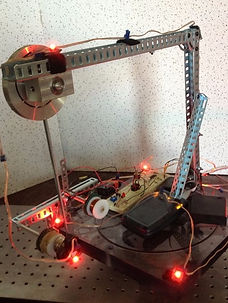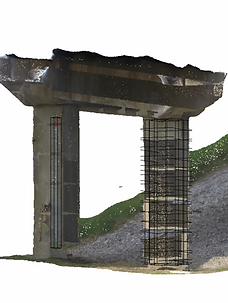
PROJECTS
Shown below are several of the projects I have been involved with over the years

Wall Climbing Inspection Robot
Climbing on concrete, masonry and brick with automated machines is difficult due to the uneven surfaces that prevent getting a good grip. This paper describes developments in using dual-durometer pneumatic suction feet for gripping onto concrete surfaces as part of a multi-legged robotic climbing system for inspecting concrete structures with vertical walls. The dual durometer technique presents a compliant suction tip to the concrete to produce a good seal against an irregular surface, and stiff component to provide the structural rigidity needed for walking. Individually actuated pneumatic Venturi vacuum generators provide the suction from positive pneumatic pressure in a manner that is robust against leaks causing systemic vacuum collapse. The feet are attached to a six-legged robot that with a nominal floor walking capability and gait. Climbing a wall requires modification to leg actuation and gait, along with suction feet. System design, integration, concrete wall climbing performance and sensor deployment in the form of a lightweight ground penetrating radar system are presented.

Ground Penetrating Radar (GPR)
Design and utilizationn of an air-coupled, ultra-wide-band (UWB) ground penetrating radar (GPR) system that is designed for assessing the condition of reinforced concrete bridge decks from a vehicle traveling at highway speeds. The hardware design combines digital signal processing techniques to create a shaped ultrawideband source with a full waveform digitizing high-speed data acquisition system. The UWB pulse generator uses a novel, yet simple, step recovery diode (SRD) based impedance matching and differentiator circuit technique, which produces a high pulse amplitude (18 Vpp) and low level ringing. By employing the 8 Gsps real time data acquisition unit to sample the reflection signals without sub-sampling, the GPR survey speed is significantly improved. This makes it applicable for highway and bridge inspection at regular driving speed.

Ambulatory Lordosimeter Measurement and Feedback Control of Seated Posture
The relation between seated posture, specifically lower back curvature or lordosis, biofeedback control, and lower back pain (LBP) is the focus of this research.
This study has three main goals; to develop a device to measure and record the curvature of the lower back, evaluate the hypothesis that bio-feedback control can be used to control seated posture, and to evaluate the hypothesis that biofeedback seated posture control can affect low back pain.
Two groups of subjects with reported LBP wear the device for a total of six weeks. One group is a control group that undergoes posture monitoring, but no feedback. The second group is a feedback group that undergoes a combination of posture monitoring, feedback and with posture-actuated feedback.

Compact, Rugged, and Low-Cost Wavelength-Versatile Burst Laser
The goal of this project was to design and build a low cost and compact commercial burst lasers to be integrated in CBRNE detection applications.
Our design demonstrated the feasibility of clearing the way toward commercial systems that meet the desired low cost, size and weight. With the design and component selection of this prototype it was possible to reduce the cost as compared to the present readily available lasers on the market that have comparable specifications.
The prototype laser has been designed to be used indoor and in outdoor field scenarios. The size and weight was optimized so that the laser and battery pack could easily and comfortably be carried. The packaging was also designed to be rugged and to reduce vibrations.

Aeroelastic Mechanics of Thin Film Membranes
This research addresses the aeroelastic mechanics of thin film membrane masks during proximity (X-ray) lithography. This ultra-high precision manufacturing process uses an X-ray source to expose resist on silicon substrates in patterns carried by a thin membrane mask that is held near to the substrate. The mask is positioned relative to the substrate wafer with a stepper tool. Positioning and alignment maneuvers cause aerodynamic loads that may give rise to unwanted deformations in the mask. The deformations in the mask feedback to alter the aerodynamic loads to produce aeroelastic effects.

Orientation Control with Vibrating Mass Gyroscope
Orientation control of satellites and other freely rotating objects presents many technical challenges. Vibrating mass gyroscopes may be able to contribute to this effort. The goal is to execute a maneuver that changes the orientation of the object without altering its angular momentum. This task is normally covered by an array of spinning rotors with nonparallel axes of rotation. Energy considerations favor the use of three-dimensional off-axis twisting of the gyroscope instead of an on-axis rotor speed adjustment. If this technique can be replaced by an equivalent vibrating mass gyroscope, then there exists the possibility of considerably miniaturizing the system and avoiding the reliability issues associated with high-speed rotors. Vibrating mass gyroscopes are routinely used for sensing change in orientation, often through the use of Coriolis effects. The possibility of using a vibrating mass combined with a properly phased velocity-orthogonal control force for orientation control is examined

Creation of 3D Structural Models from High Resolution Imaging
This projects looks at new innovative methods for Low-cost high-quality image processing for structural condition assessment. 3D point clouds are created from a series of high resolution images of structures taken from various locations and angles. These 3D cloud points are then processed and integrated into structural modeling software where further analysis can be performed.